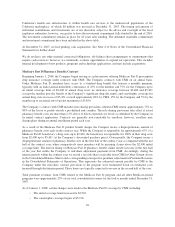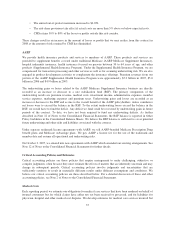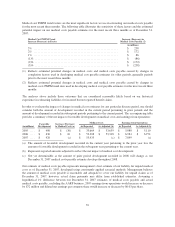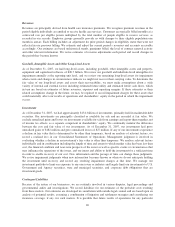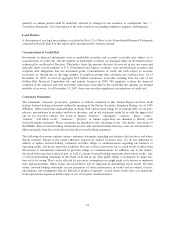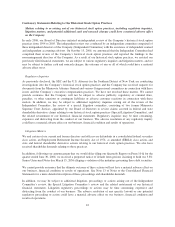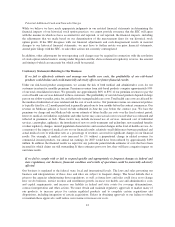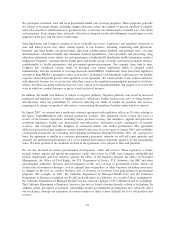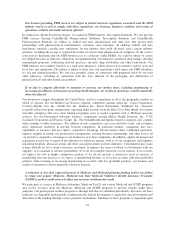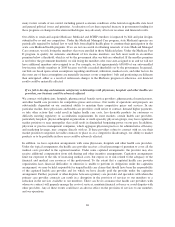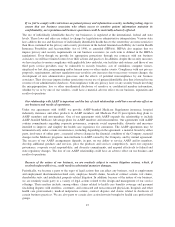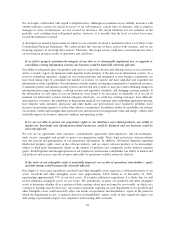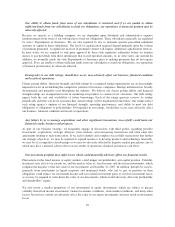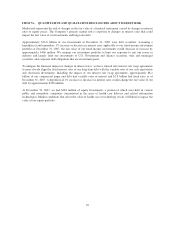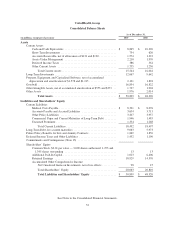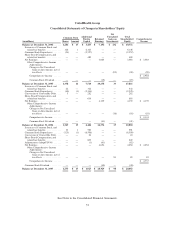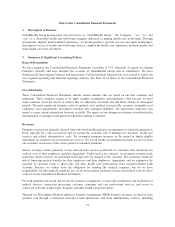United Healthcare 2007 Annual Report Download - page 48
Download and view the complete annual report
Please find page 48 of the 2007 United Healthcare annual report below. You can navigate through the pages in the report by either clicking on the pages listed below, or by using the keyword search tool below to find specific information within the annual report.many factors outside of our control, including general economic conditions at the federal or applicable state level
and general political issues and priorities. A reduction or less than expected increase in government funding for
these programs or change in allocation methodologies may adversely affect our revenues and financial results.
Our ability to retain and acquire Medicare, Medicaid and SCHIP enrollees is impacted by bids and plan designs
submitted by us and our competitors. Under the Medicaid Managed Care program, state Medicaid agencies are
periodically required by federal law to seek bids from eligible health plans to continue their participation in the
acute care Medicaid health programs. If we are not successful in obtaining renewals of state Medicaid Managed
Care contracts, we risk losing the members that were enrolled in those Medicaid plans. Under the Medicare Part
D program, to qualify for automatic enrollment of low income members, our bids must result in an enrollee
premium below a threshold, which is set by the government after our bids are submitted. If the enrollee premium
is not below the government threshold, we risk losing the members who were auto-assigned to us and we will not
have additional members auto-assigned to us. For example, we lost approximately 650,000 of our auto-enrolled
low-income subsidy members in 2008 because our bids exceeded thresholds set by the government. In general,
our bids are based upon certain assumptions regarding enrollment, utilization, medical costs, and other factors. In
the event any of these assumptions are materially incorrect or our competitors’ bids and positioning are different
than anticipated, either as a result of unforeseen changes to the Medicare program or otherwise, our financial
results could be materially affected.
If we fail to develop and maintain satisfactory relationships with physicians, hospitals and other health care
providers, our business could be adversely affected.
We contract with physicians, hospitals, pharmaceutical benefit service providers, pharmaceutical manufacturers,
and other health care providers for competitive prices and services. Our results of operations and prospects are
substantially dependent on our continued ability to maintain these competitive prices and services. In any
particular market, these physicians and health care providers could refuse to contract, demand higher payments,
or take other actions that could result in higher health care costs, less desirable products for customers or
difficulty meeting regulatory or accreditation requirements. In some markets, certain health care providers,
particularly hospitals, physician/hospital organizations or multi-specialty physician groups, may have significant
market positions or near monopolies that could result in diminished bargaining power on our part. In addition,
physician or practice management companies, which aggregate physician practices for administrative efficiency
and marketing leverage, may compete directly with us. If these providers refuse to contract with us, use their
market position to negotiate favorable contracts or place us at a competitive disadvantage, our ability to market
products or to be profitable in those areas could be adversely affected.
In addition, we have capitation arrangements with some physicians, hospitals and other health care providers.
Under the typical arrangement, the health care provider receives a fixed percentage of premium to cover all the
medical costs provided to the capitated member. Under some capitated arrangements, the provider may also
receive additional compensation from risk sharing and other incentive arrangements. Capitation arrangements
limit our exposure to the risk of increasing medical costs, but expose us to risk related to the adequacy of the
financial and medical care resources of the professional. To the extent that a capitated health care provider
organization faces financial difficulties or otherwise is unable to perform its obligations under the capitation
arrangement, we may be held responsible for unpaid health care claims that should have been the responsibility
of the capitated health care provider and for which we have already paid the provider under the capitation
arrangement. Further, payment or other disputes between a primary care provider and specialists with whom the
primary care provider contracts can result in a disruption in the provision of services to our members or a
reduction in the services available to our members. There can be no assurance that health care providers with
whom we contract will properly manage the costs of services, maintain financial solvency or avoid disputes with
other providers. Any of these events could have an adverse effect on the provision of services to our members
and our operations.
46


